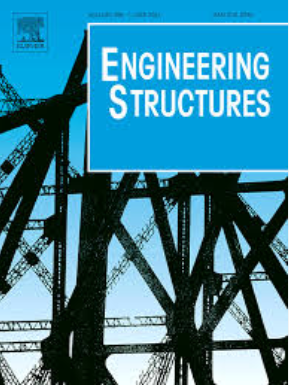Seismic behavior and vulnerability of thin-walled stirrup-confined CFST piers: Pseudo-dynamic experimental and numerical analysis
IF 5.6
1区 工程技术
Q1 ENGINEERING, CIVIL
引用次数: 0
Abstract
The pseudo-static test is a widely used, cost-effective method for evaluating seismic resistance. However, its reliance on monotonic cyclic loading fails to replicate inertial forces. It neglects the influence of strain rates on materials, thus limiting its ability to simulate pier failure mechanisms accurately during actual earthquake events. This study conducted pseudo-dynamic tests and elastoplastic analyses using solid-shell elements on stirrup-confined concrete-filled steel tube (CFST) piers. The investigation focused on the effects of stirrup confinement on displacement response, stiffness degradation, and voiding phenomena under seismic loading. Additionally, an incremental dynamic analysis (IDA) was performed, utilizing the finite element model's precision in predicting peak displacements to assess the vulnerability of stirrup-confined CFST piers. The findings demonstrate that stirrup confinement significantly reduces displacement magnitude, mitigates stiffness degradation, alleviates void formation, and substantially decreases the risk of earthquake-induced damage.
薄壁箍筋约束CFST桥墩抗震性能与脆弱性:拟动力试验与数值分析
拟静力试验是一种广泛使用的、经济有效的抗震评估方法。然而,它对单调循环加载的依赖不能复制惯性力。它忽略了应变率对材料的影响,从而限制了它在实际地震事件中准确模拟桥墩破坏机制的能力。本文采用实心壳单元对箍筋钢管混凝土(CFST)桥墩进行了拟动力试验和弹塑性分析。研究的重点是箍筋约束对地震荷载下的位移响应、刚度退化和空洞现象的影响。此外,还进行了增量动力分析(IDA),利用有限元模型预测峰值位移的精度来评估箍筋约束CFST桥墩的脆弱性。研究结果表明,箍筋约束显著降低了位移幅度,缓解了刚度退化,缓解了空洞的形成,并大大降低了地震引起的破坏风险。
本文章由计算机程序翻译,如有差异,请以英文原文为准。
求助全文
约1分钟内获得全文
求助全文
来源期刊

Engineering Structures
工程技术-工程:土木
CiteScore
10.20
自引率
14.50%
发文量
1385
审稿时长
67 days
期刊介绍:
Engineering Structures provides a forum for a broad blend of scientific and technical papers to reflect the evolving needs of the structural engineering and structural mechanics communities. Particularly welcome are contributions dealing with applications of structural engineering and mechanics principles in all areas of technology. The journal aspires to a broad and integrated coverage of the effects of dynamic loadings and of the modelling techniques whereby the structural response to these loadings may be computed.
The scope of Engineering Structures encompasses, but is not restricted to, the following areas: infrastructure engineering; earthquake engineering; structure-fluid-soil interaction; wind engineering; fire engineering; blast engineering; structural reliability/stability; life assessment/integrity; structural health monitoring; multi-hazard engineering; structural dynamics; optimization; expert systems; experimental modelling; performance-based design; multiscale analysis; value engineering.
Topics of interest include: tall buildings; innovative structures; environmentally responsive structures; bridges; stadiums; commercial and public buildings; transmission towers; television and telecommunication masts; foldable structures; cooling towers; plates and shells; suspension structures; protective structures; smart structures; nuclear reactors; dams; pressure vessels; pipelines; tunnels.
Engineering Structures also publishes review articles, short communications and discussions, book reviews, and a diary on international events related to any aspect of structural engineering.
 求助内容:
求助内容: 应助结果提醒方式:
应助结果提醒方式:


